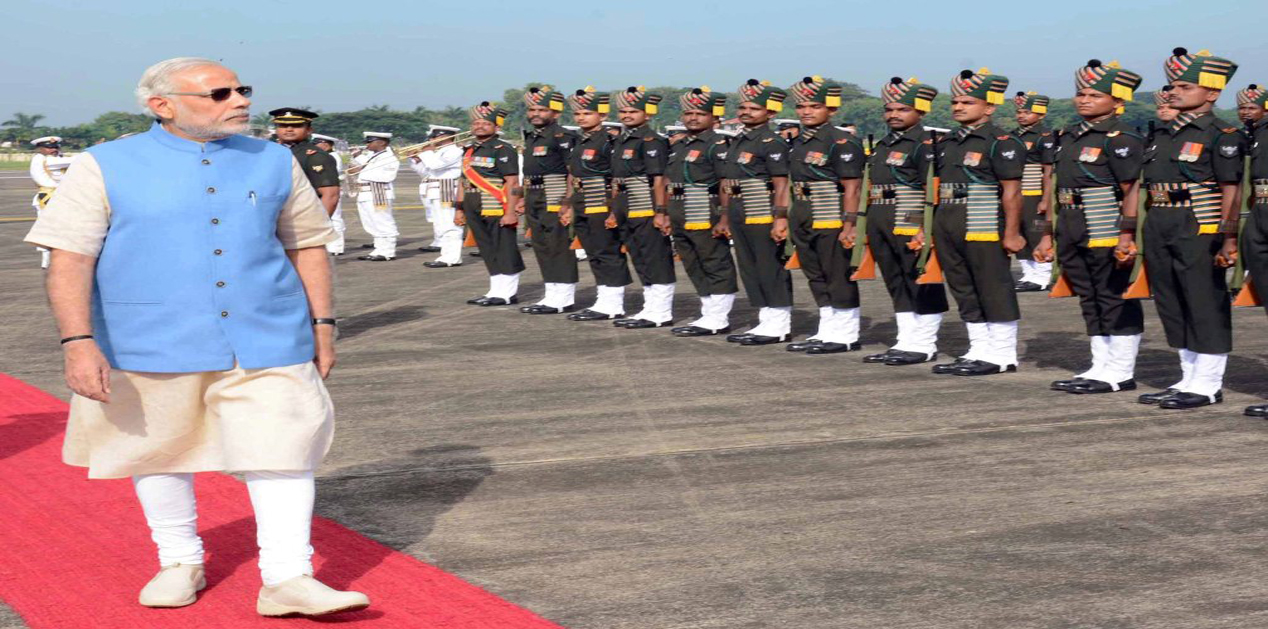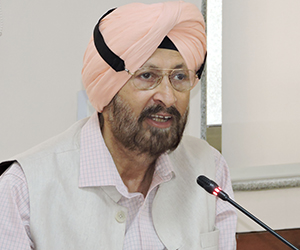Defence Preparedness
On January 21, 2017, Prime Minister Narendra Modi addressed the army, navy and air force commanders’ conference at the Indian Military Academy, Dehradun.While the text of the PM’s address has not been released, ostensibly due to restrictions imposed by the Election Commission, it has been reported that presentations on the state of India’s operational preparedness and long-pending defence reforms were made to the PM.
On December 15, 2015, while addressing the commanders’conference on board INS Vikramaditya the PM had described India’s neighbourhood as a difficult one that presented the full spectrum of threats to national security. The challenges included a reckless nuclear build-up; cross-border terrorism; cease-fire violations; transgressions across unsettled borders; and, continuing military modernisation and expansion.
The PM had then said, “We will continue to strengthen our defence capabilities and infrastructure, engage our neighbours more closely and strengthen our regional and global partnerships, including in maritime security.” He had also promised to reform the defence acquisition process and ensure that defence procurement contributes meaningfully to his mission to ‘make in India’.
For many years now ‘critical hollowness’ operational preparedness has been undermining national security. The term was used by General V K Singhin the letter he had written as COAS to the then Prime Minister in May 2012.Deficiencies in ammunition and important items of weapons and equipment are hinderingthe readiness of the armed forces for war and their ability to sustain operations over the anticipated time periods.
According to a recent CAG report, the army has stocks of some varieties of ammunition for barely ten days of conflict and it will cost Rs 19,000 core to increase stocks to the required level. It will be recalled that during the Kargil conflict in 1999, as many as 50,000 rounds of Bofors ammunition had to be imported from South Africa. The recurrence of a similar situation during a time of crisis must be avoided through a prudent stocking and replenishment policy.
Modern wars are fought mostly during the hours of darkness, but many of the armoured fighting vehicles – tanks and infantry combat vehicles – are still ‘night blind’. Also, warships, submarines, fighter aircraft, light helicopters, artillery guns, ground-based air defence systems and command and control and surveillance and reconnaissance systems are either held in inadequate numbers or are bordering on obsolescence.
Among the structural reforms that need to be implemented in an early time frame the most important issue is the appointment of a Chief of Defence Staff (CDS) as a single-point military advisor to the government.The post of CDS was first recommended by the Arun Singh Committee on Defence Expenditure in the early 1990s.
The Group of Ministers (GoM) chaired by Deputy PM L K Advani in 2001 also recommended that a CDS be appointed. The GoMhad constituted four task forces to review the recommendations made by the Kargil Review Committee and one of these was on higher defence management.
This crucial appointment has been hanging fire since then due to the lack of consensus. Recently, the Naresh Chandra committee has recommended the appointment of a permanent Chairman of the Chiefs of Staff Committee (CoSC) as a more acceptable alternative.
The appointment of a CDS should be followed by the merger of single-Service operational commands into tri-Service integrated theatre commands forthe planning and execution of joint operations. It is now accepted by all modern militaries that joint planning leads to the synergisation of the combat capabilities of individual Services.
Also, the Army, Navy and Air Force HQ have been only notionally integrated with the Ministry of Defence (MoD) and are still ‘attached offices’ of the MoD for all practical purposes. The civil-military heartburn and the consequent weaknesses in functioning caused by this lacuna must be removed.
Modernisation of the armed forces has been stagnating due to the inadequacy of budgetary support, cumbersome procurement procedures and delays in decision making.Defence Minister Manohar Parrikar has taken several positive steps to hasten defence procurement. Approval of necessity (AON) has been accorded to defence acquisition projects worth approximately Rs 150,000 crore.
Though only a few contracts have actually been signed so far, including the purchase of Rafale fighter aircraft, M-777 howitzers, Apache attack helicopters and Chinook medium lift helicopters, the stagnation in military modernisation over the UPA government’s ten years in power has been arrested.
The 12th Defence Plan (2012-17) will end on March 31, 2017.It was never formally approved or given financial backing by the Cabinet Committee on Security (CCS). The government has also not formally approved the long-term integrated perspective plan (LTIPP 2007-22) formulated by HQ Integrated Defence Staff.
Without these essential approvals, defence procurement is being undertaken through ad hoc annual procurement plans, rather than being based on duly prioritised long-term plans that are designed to systematically enhance the combat potential of the armed forces. These are serious lacunae in long-term defence planning and must be rectified in an early time frame.
Defence Equipment
The national aim should be to make India a design, development, manufacturing, export and servicing hub for defence equipment. The government must relinquish its monopoly on defence research and development (R&D). The DRDO should limit its research to strategic technologies that even the closest strategic partners are unwilling to share. The remaining R&D projects should be entrusted to the private sector and the IITs and universities. The MoD should progressively move away from its excessive reliance on inefficient defence public sector undertakings (DPSUs) for indigenous production. Most of the DPSUs should be gradually privatised.
The private sector must be encouraged and incentivised to contribute to the national quest for self-reliance in defence production. The PM’s vision to ‘make in India’ must lead to substantive upgradation of India’s defence technology base and manufacturing capability, or else the country’s defence procurement will remain mired in disadvantageous buyer-seller, patron-client relationships. No new defence acquisition should be undertaken without insisting on the transfer of technology (ToT).
The NDA government has announced its intention to allow defence exports. The national aim should be to make India a design, development, manufacturing, export and servicing hub for weapons systems and other defence equipment in the next 10 to 15 years.
Defence Budget
Financial management too needs a major overhaul. The defence budget has dipped to 1.74 per cent of the country’s GDP – the lowest level since the 1962 war with China – despite the fact that Parliament’s Standing Committee on Defence and the armed forces have repeatedly recommended that it should be raised progressively to 3.0 per cent of the GDP.
Varying portions of the budgetary allocations earmarked on the capital account for the modernisation of the armed forces will continue to be surrendered unless the government sets up a rolling, non-lapsable defence modernisation fund of about Rs 1,00,000 crore under the Consolidated Fund of India.
If India is to build the defence capabilities necessary to meet future threats and challenges and discharge its growing responsibilities as a regional power in southern Asia, the measures recommended above must receive the PM’s personal attention for implementation in an early time frame.
(The writer is Visiting Fellow, VIF and Distinguished Fellow, Institute for Defence Studies and Analyses (IDSA), New Delhi)











Post new comment